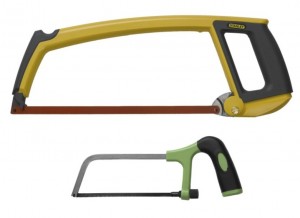Handsaws
Handsaws will always be important tools in any DIY toolkit, in spite of the fact that you can now buy a power saw for almost every cutting need. Handsaws are clearly much cheaper than their powered counterparts, so unless you are at the very serious end of the DIY spectrum, then buying all the circular and reciprocating saws that are available is simply not necessary. Also, there are many jobs when a handsaw is the only option to use, and sometimes it’s just much quicker and easier to pick up a handsaw, rather than getting your power saw out. There is a huge variety of handsaws on the market, but below I’ve stripped things right back to what I believe to be the three handsaw types that you actually need in your toolkit.
Panel saws

The simple panel saw is the most all purpose of the entire saw family.
Panel saws are the most commonly used of all handsaws, as they are designed for cutting wood of just about any variety. If you’ve got a panel saw, you can cut hardwoods and softwoods, lengths of timber, sheets of ply, kitchen worktops, chipboard floor sheets, and the list goes on an on.
Once a panel saw starts to lose its sharpness you can then get further use out of it, by using it to cut non-wooden materials that will tend to blunt the teeth further, but such materials don’t actually need particularly sharp teeth to make a cut. A few examples of things to cut with a blunt saw include plasterboard, insulation sheets, insulation rolls, soft stone, and even rolls of turf (not joking, tried it the other day and it was brilliant!).
So, panel saws are truly the most all purpose of the saw family, and they continue to have a use even when the blade starts to lose its ‘edge’. For more on the perfect size, number of teeth, and price, see my guide – ‘Buying a handsaw’.Â
Drywall saws

The drywall saw, or padsaw, is the ideal tool for cutting holes in plasterboard.
Most homes have plasterboard ceilings, and if your home has stud walls, that means they will generally be covered in plasterboard, and the easiest way to cut a hole in plasterboard is with a drywall saw.
The drywall saw is perfectly designed to be able to firstly ‘punch’ a hole in the plasterboard, after which you can saw as normal to remove the required section. The most common use I have for a drywall saw is when I need to repair a hole in a wall, and if you need to see a practical demonstration, check out my guide – ‘Filling large holes in solid walls’.
Hacksaws

A hacksaw is a must have item if you need to cut any metal, and I find the junior hacksaw to be more than capable in most situations.
A hacksaw is needed for those occasions when you need to cut metal, as the fine teeth and grade of steel used in the blade is designed to cut pretty much any type of metal you’ll come across in the household, such as aluminium door thresholds, metal curtain poles, bolts, door spindles etc.
In terms of the size, there are two options, a large hacksaw (above right) or the smaller, and rather cutely named, junior hacksaw (below right). Personally, I find that there’s not much that the junior hacksaw won’t do, and I must admit that for anything ‘heavy duty’ I will always reach for my angle grinder. Therefore, if you had to buy just one of these two hacksaw types, I don’t think you can go too far wrong with a good quality junior hacksaw. More on this in my ‘junior hacksaw‘ buying guide.
Now, there are a few more handsaw options out there, such as tenon saws, coping saws, fret saws and the like, but I really don’t think they are ‘must have’ items unless you’re at the serious woodworking end of the DIY scale. Therefore, make sure you’ve got the three handsaw types shown above, and you’ll be very well equipped for pretty much any DIY sawing jobs that come your way.
